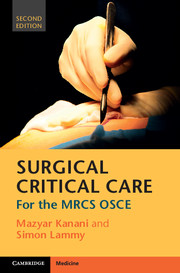6 - Intensive care unit (ICU)
from Section 2 - Intensive care (level 3)
Published online by Cambridge University Press: 05 July 2015
Summary
Assessment
Agitation and sedation
Give some causes of acute confusion in the post-operative patient
Pain (anxiety and disorientation): all of these can commonly occur in critically ill patients
Sepsis: systemic infection, or localised to chest, urinary tract, wound, intra-abdominal, intrathoracic, intracranial collection
Glycaemic disturbances: this occurs most commonly with hypoglycaemia, but can occur in hyperglycaemia, e.g. ketoacidosis
Metabolic: electrolyte disturbances can precipitate agitation, most commonly hypo- or hypernatraemia
Respiratory: a compromise in respiratory function can lead to hypoxaemia and hypercarbia. Usual precipitating causes, apart from a chest infection, include acute pulmonary oedema, pneumothorax, pulmonary embolism, sputum retention and subsequent atelectasis
Cardiovascular: low cardiac output state and hypotension from any cause, e.g. bleeding, myocardial infarction, arrhythmia leading to reduced cerebral perfusion
Renal: acute kidney injury and hepatic failure can cause the accumulation of encephalopathic toxins to develop, e.g. uraemia. Urinary retention in the elderly can be a causative factor
Fluid imbalance: both dehydration and water overload can exacerbate the hyponatraemia due to the fluid retention from the stress response to surgery
Drugs: e.g. opiate analgesia, excess sedative drugs, anticholinergics
Which investigations should you perform?
Following a full history and examination investigations include
Bedside investigations
Boehringer Mannheim (BM): this rapidly assesses if the capillary glucose is low and this provides a value 7% higher than plasma values
Arterial blood gas (ABG) analysis: this determines the base excess and respiratory function, e.g. if hypoxia or hypercarbia is present
Electrocardiograph (ECG): for arrhythmias or myocardial infarction that can reduce the cerebral perfusion
Non-bedside investigations
Haematology: the full blood count (FBC) needs to be assessed for presence of infection, e.g. leucocytosis, neutrophilia and anaemia
Biochemistry: this includes serum electrolytes and base renal function (U&Es), e.g. sodium, potassium, calcium, phosphate and magnesium to correct electrolyte disturbances, and urea and creatinine to help guide fluid therapy. The inclusion of liver function tests (LFTs) helps to determine hypoalbuminaemia
Microbiology (sepsis screen): blood cultures, wound swabs, urine and sputum cultures to detect the presence of occult infection
Radiology: such as a chest radiograph to detect a chest Infection
What is the purpose of sedation in the critical care setting?
- Type
- Chapter
- Information
- Surgical Critical CareFor the MRCS OSCE, pp. 253 - 302Publisher: Cambridge University PressPrint publication year: 2015

